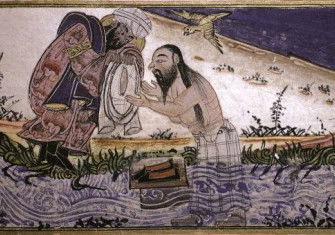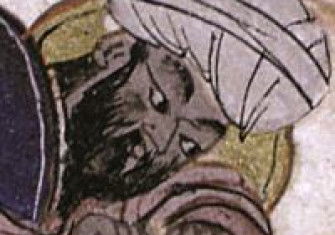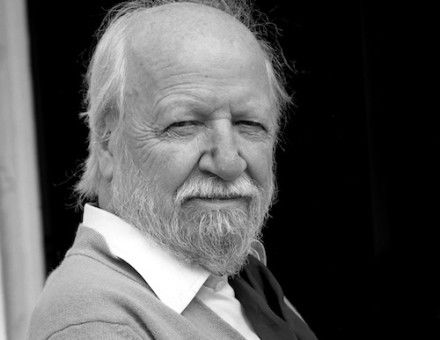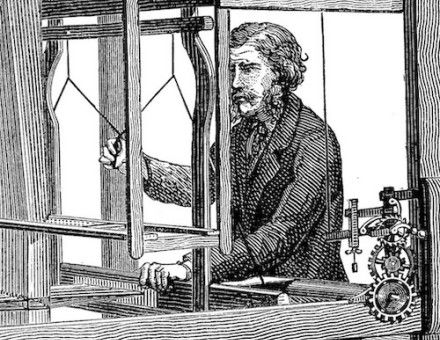The Origin of the Whirling Dervishes
From their origins in the 13th century until the suppression of the Sufis by Atatürk, the whirling dervishes symbolized their beliefs through their ecstatic dances.
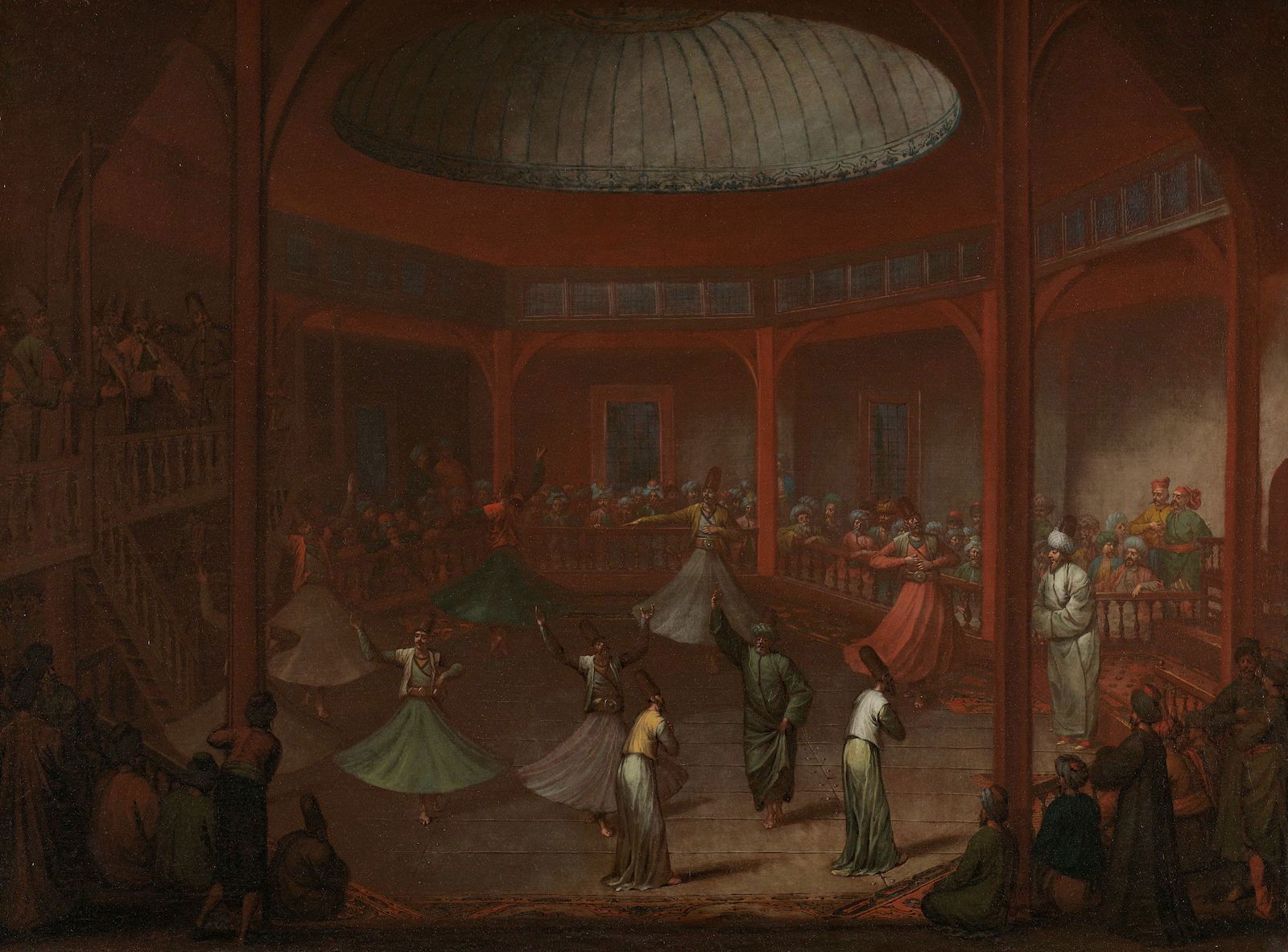
The whirling dervishes were founded by Jalāl al-Dīn Muḥammad Rūmī (1207-1273), known to his followers as Mevlana, ‘our master’, and they flourished in Turkey until 1926, when they were suppressed by Mustafa Kemal Atatürk. But since 1956 the Turkish Government has permitted an annual celebration at Konya in Anatolia, where Rumi lived from the age of fourteen until his death, and where he is buried, of a week of whirling or, as the dervishes prefer to call it, of ‘turning’, which culminates each year on the anniversary of the Seb-i Arus, ‘the nuptial night’, that of Rumi’s death, on December 17th.
The performers, called ‘turners’ or ‘dervishes’, number around twenty-five; their ages vary from eight to eighty-nine. The musicians generally number about forty. All the performers are Mevlevis, members of the Muslim Mevlevi (or Mewlewī) Order – the Sufi (mystic congregation) order founded by Rumi. All whirling dervishes are Mevlevis, but by no means all Mevlevis are ‘turners’, though all may become so - if they wish to and can learn to ‘turn’.
The grandmaster or chief of all the Mevlevis is always a direct descendant of Rumi, and must be from the same family. Mevlana fled from Balkh in Persia in 1219 at the age of twelve with his family to escape Mongol persecution. The family visited several Near Eastern cities, and settled at Konya, Turkey in 1226-1227.
Wherever they ‘turn’, the dervishes hang a curtain depicting the sun on one wall. This is because Rumi’s great book the Divan-i Shams-i Tabrizi was written as a memorial to his Sufi teacher and friend, Shams-i Tabrīzī, and Shams means ‘sun’ in Persian. Shams, after bringing Rumi to the Sufi understanding, disappeared mysteriously, in all probability murdered by other of Rumi’s friends, who were jealous of his influence. Long inconsolable, Rumi finally transferred his affection to a young dervish, Husam al-Din Chalabi, for whom he wrote his other great work, the Masnavi.
The muquabala - the whole dervish performance (the actual whirling is called the sama)- begins with the musicians tiling in. The musicians all wear the dervish costume: long black cloaks, representing the grave, high felt hats, representing the tombstone. These hats may now be of any colour, though originally only members of the Çelebi family, descended from Rumi, might wear white hats.
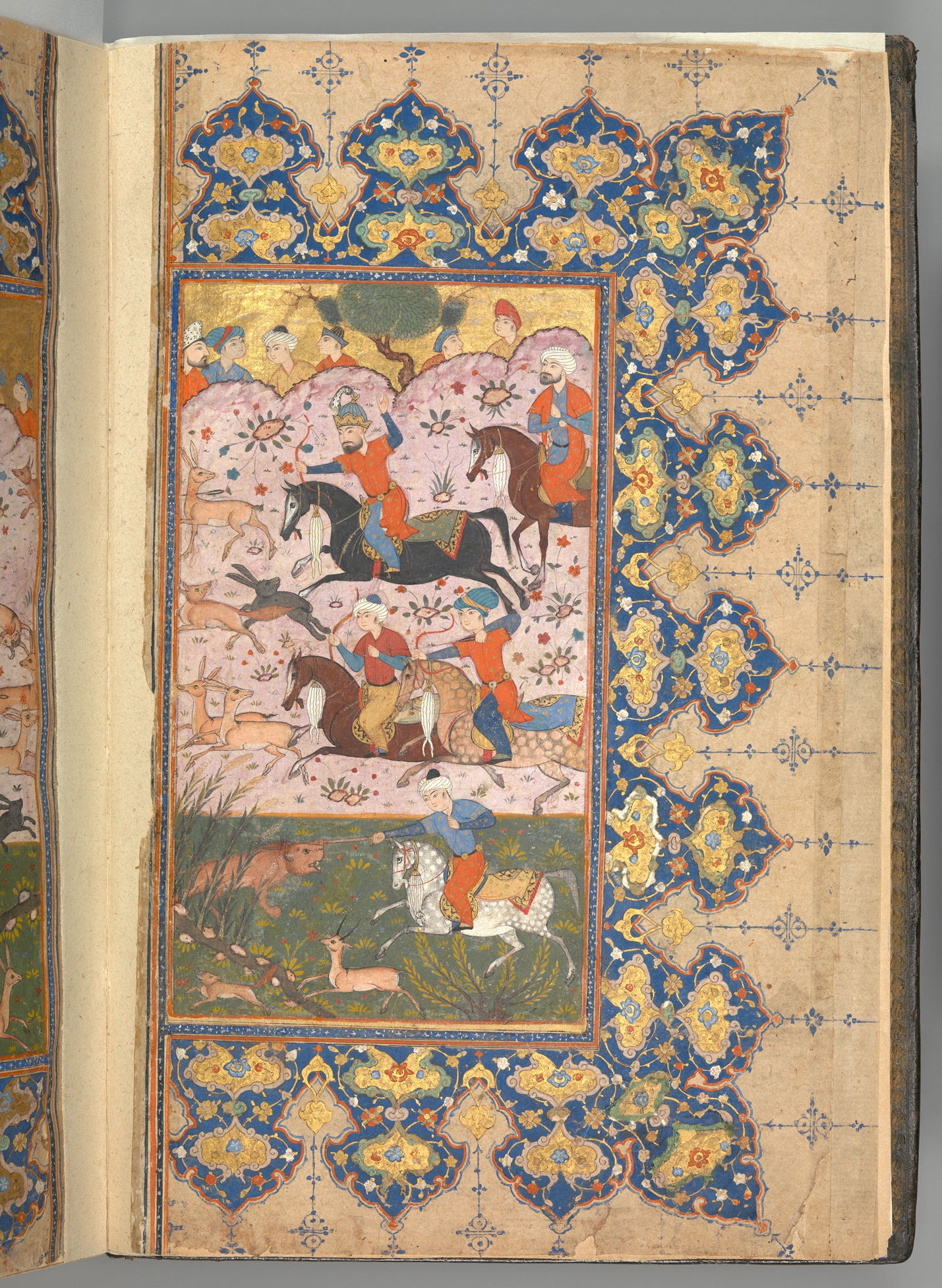
Generally the hats are saffron; and, underneath them, white cotton suits, with very tight, white trousers and soft black boots or slippers are worn. Among the musical instruments used are tambourines (def or tef); cymbals (halile); rebabs (one-string stretched across a coconut shell); violas; violins; drums (kudum or qudum )’, and flutes (ney ). The latter are seven-holed, for the seven holes in the human body: two nostrils, two ears, one mouth and two orifices.
While the musicians are taking their places, the turners or dancers file in and range themselves, standing on either side. In pre-1926 days, novices stood on the left, dervishes on the right. The sheykh, or leader of the sama, who is generally also a teacher of turning - there are three in Konya - takes his place in the centre, on a red sheepskin called the postnisin or seyh. A ritual prayer is intoned, never by the sheykh, but by one of the older ‘turners’, who acts as imam or priest. Now, a few verses from the Koran are sung.
The musicians next play improvisations on music of the Saba rite, named for the dawn wind that blows in Anatolia in spring and fall. In the key of D flat, the words are taken from Sultan Veled’s Rabapname (Sultan Veled was the third grandmaster of the Mevlevi order and Rumi’s son):
‘Thou art the unseen and the seen
Had no clue.
Thou art hiding in bodies and souls
Had no clue.
I was looking for a sign of Thine in this world.
At last I have found that the world itself is a sign of Thine;
Now I have a clue.’
A roll of drums, and the dervishes stand. This is supposed to represent both the roll-call after creation, when God first called every creature by its name, and it replied, ‘Here am I’, and the last trump, when, once again, every being will be called, the dead standing up from out of their graves, to answer to the judgment. The ‘turners’ begin to walk, counter-clockwise, slowly, in a single file. As they reach the sheepskin, each bows to it, and to the man behind him, who returns his bow; at the point opposite the sheepskin, the bows are repeated in a symbolic gesture which unites and, at the same time, separates the two halves of the circle.
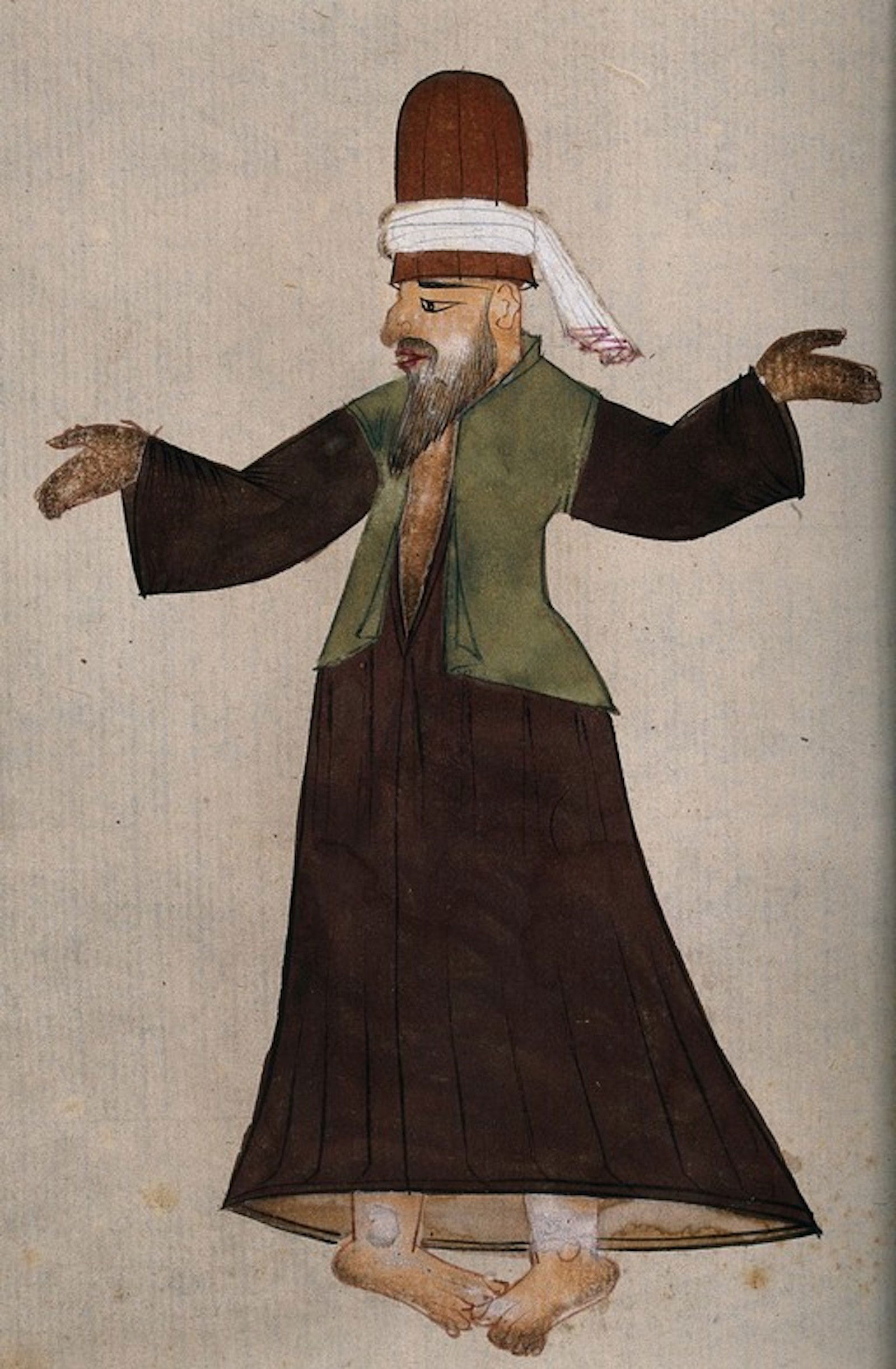
Next they promenade around the area three times, representing mineral, vegetable and animal life. At the end of the third circle, with a simultaneous movement, they all throw off their long black cloaks, and in this gesture, symbolical of the resurrection, are revealed wearing the same white cotton suits as the musicians, with the addition of ankle-length skirts cut very full, generally, but not necessarily, white. ‘Turning’ used to be done barefoot; now the whirling dervishes wear soft leather slippers or boots.
All walk again past the sheykh, in file, and stoop to kiss his hand. Then, arms crossed on their breasts, they walk simply into the open space and start turning. The impression is of men moving into pleasant warm water and beginning to swim. As they turn, they uncross their arms, slowly, then gradually lift them slightly above shoulder height. They turn the right palm upward, to receive God’s grace, and the left downward, to pour it upon the earth. They move anti-clockwise, towards the heart only; for the Mevlevi way is the way of divine love, and the dancers turn from the west of non-existence to the east of God’s sole existence. They take small steps like reverse waltzing.
The variety of individual styles of ‘turning’ is amazing: no two dervishes ever turn alike. Some move smoothly; some almost polka; some stay on their toes; others are flat-footed. The children are as gauche as children at any dancing class; yet some do it very well. Some turners carry themselves very straight, others sway in a feminine way; but none move their heads separately, and all carry them inclined slightly to the right.
One dervish, called the Samazan, in green to distinguish him from the ‘turners’, walks discreetly among them to prevent possible collisions or bunching in one place of the dancers; he merely moves himself towards a possibly crowded area, and that suffices - one has indeed the impression that the ‘turners’ are more aware, more awake, not less, than usual, and at no time is there the slightest sense of congestion. The first ‘turn’ lasts about fifteen minutes. Then the music stops. The dancers stop instantly, as though playing musical chairs, and return to the sides, where they remain standing, in groups of three - in case anyone feels dizzy - for about three minutes. They stand upright, no one swaying.
The second turn begins again with the single file past the sheykh and the bowing to him; then the turning again, this time for only about eight minutes. Another three minutes rest, and the third turning is the longest - about eighteen minutes, and during it the music changes, to a faster, jerkier tempo. Another rest, of approximately the same time, and then the fourth turning during which the sheykh begins, very slowly, to turn upon himself. The turners represent the planets in orbit turning around tht sheykh, who symbolizes the sun; during the fourth turn, the sun also turns upon itself, on a short straight course.
When the music stops for the fourth time, the dervishes sit, prostrate themselves, then sit again. A dervish who has not been turning covers each turner with his cloak. Anyone may stop turning at any of the intervals, and simply does not rejoin the others, but remains standing on the side until the end: old men and children rarely complete all four turns.
The first turning represents the going-forth of creation from the Unity: the universal intellect, the soul of the universe, the spheres of the planets, the minerals, plants, animals and finally man are differentiated. The second turning is man’s ascension to God by means of mystic exercise. The third turning is annihilation in God; it symbolizes the supreme degree of certainty: ‘in dying you have freed yourselves from death; by annihilation you have found me again’. The fourth turning is the eternal order restored, when God Himself turns too.
After the end of the fourth turning there is singing; one man steps out and says the Fatiha and the lkhlas - Chapters 1 and 22 of the Quran used as prayers for the dead - to which the sheykh responds.
In Konya, on the Feast of the Assumption, the night of the Mi'raj of Muhammad’s miraculous journey to heaven - ‘he did not remain there, like Jesus, he came back to earth’ the Sufis say - the musicians at the end of the turning come down from their gallery and each performer, musician or dancer, gives every other the Mevlevi handshake, by which simultaneously both right hands are lifted to both pairs of Ups. Afterwards all Mevlevi thus greet each other - women kiss men’s hands, men women’s, indifferently. The Mi'raj, or Night Journey, is ’said by many scholars to have been the inspiration for Dante’s Divine Comedy.
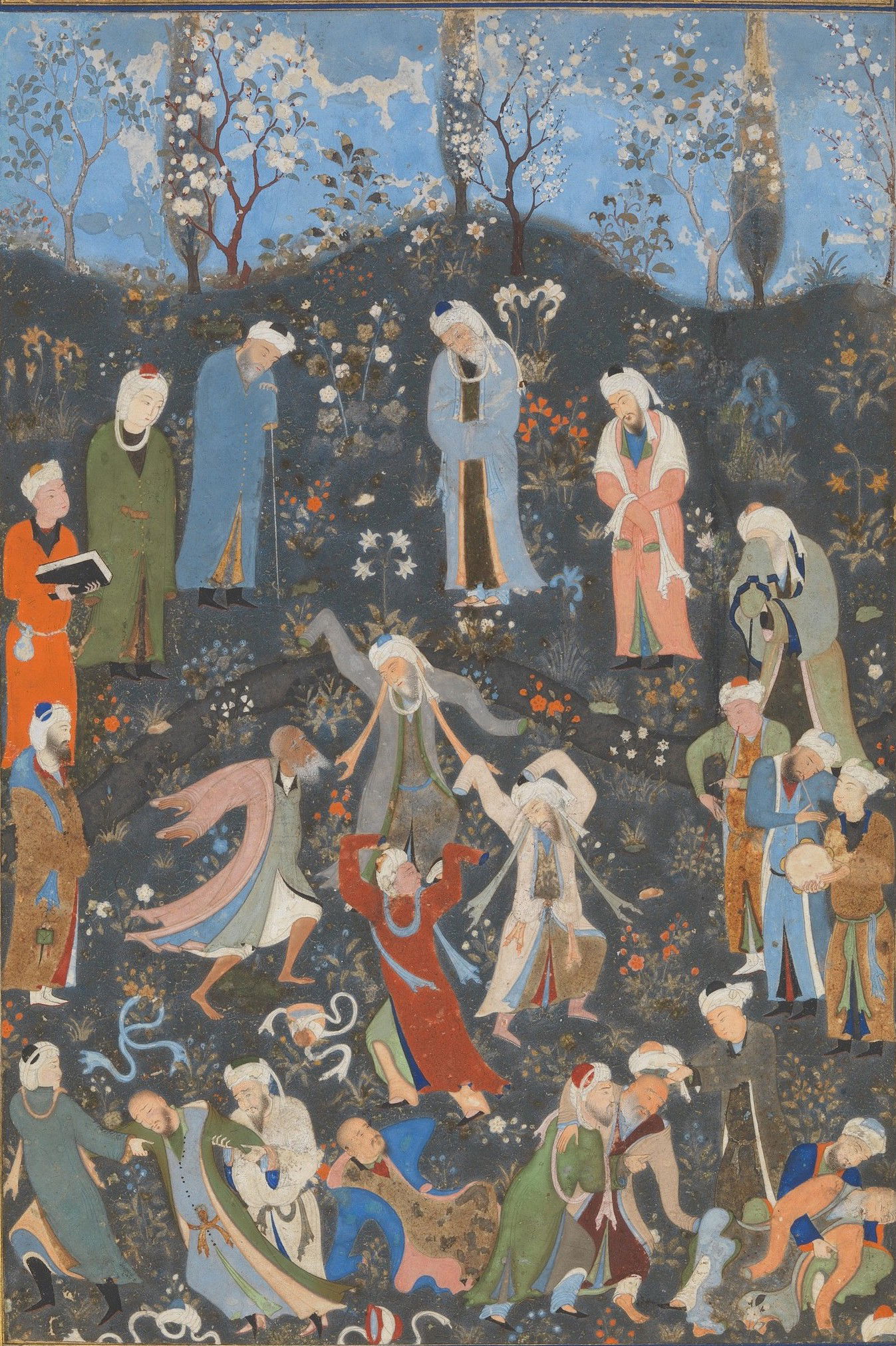
Rumi’s father was a Sufi, and became a professor at Konya after escaping from Balkh in Afghanistan. After his father’s death, Rumi succeeded to his professorship. Rumi was of a sallow complexion, thin and lean; he was peaceful and tolerant to all, and ‘was never heard to utter one bitter reply’. Rumi’s father’s tomb, his own, and his son’s are all in a mausoleum at Konya: they are topped by black stone turbans, encircling the white stone dervish hat on every man’s tomb.
Today there is no way of knowing how many Mevlevis there are in Turkey; for, since the suppression in 1926, the ‘folkloric’ celebration at Konya is the only public gathering of Mevlevis allowed by the Turkish Government. The reasons for the suppression go back a long way. From the middle of the 17th century on, the grandmaster of the Mevlevis played an important part in the enthronement of the Ottoman Sultan. In fact, he tied his belt, which was the Turkish equivalent of a coronation.
Thus the Mevlevis had become, personally and as a brotherhood, rich, powerful and politically important; the Sultan’s chief officers were all Mevlevis. Some Mevlevi families acquired much land. When the Sultanate was overthrown, Atatürk feared the Mevlevi meetings would prove to be centres of right-wing resistance. Other brotherhoods, such as the bektashis, were also forbidden, but were less feared, one reason being that they attracted humbler and less educated people. Bektashi celebrations are all in Turkish.
Rumi’s Masnavi is written in Persian, presupposing more education - and a bi-lingual one - among the Mevlevis; for all Mevlevi chanting is done in Arabic or Persian. The bektashis allow ‘mixed’ turning or dancing, and at some of their gatherings wine is drunk. This has made them suspect to pious Muslims, and ‘far out’ religiously. Whereas the Mevlevis were loyal to the Sultan, and kept close contact with the orthodox majority, from whom they never wished to be separated. ‘To be publicly with men, privately with God,’ is one of their axioms.
The freemasons, also, were outlawed by Ataturk, for the same reasons as the Mevlevis. It was only after Prime Minister Menderes (later hanged) succumbed to the pressure put on him by international freemasons and allowed the re-establishment of the Turkish masons, that the Mevlevis petitioned for, and were allowed, their small comeback.
Religious dancing is supposed, by those who disapprove of it, to have begun with the Israelite capers before the golden calf. Its friends claim David dancing before the ark as its origin. The Mevlevis’ sama is supposed to have begun with Rumi’s anguish over the loss of his mentor Shems. Rumi’s son, Sultan Veled, wrote:
‘Separation made the sheykh lose his wits; he became drunk, not with wine, but with light, and in this state he began to dance.’
Rumi was a frequent visitor to some of the Greek monks who lived in the caves near Konya, and there was a Hicete tradition there of meetings in monasteries for hymn-singing and dancing. This tradition goes back to the Apocryphal Acts of John, which describe how, before his passion, Jesus told the twelve to circle around him, holding hands, and said:
‘I will mourn my death. Mourn ye. Amen. The unique octave, sing it among yourselves. Amen. The twelfth number dances. Amen. Each of you shall dance. Amen. He who will dance ignores what is to be. Amen.’
As early as the fifth century A.D. the Messalians practised perpetual prayer and also danced; for both they were condemned in 431 at the Council of Ephesus, no great distance from Konya. There are also fairly close links between Sufism and both Buddhism and Hinduism. There was a Buddhist, Simnani, at the court of Persia, and the Hindu tradition of dancing is reflected in the fact that the Sufi names for the three interior senses are tantric. (For the Hindus, Siva’s dance creates, sustains, and, finally, destroys the universe.)
Some great Muslim poets, among them Djami, did not care for the Mevlevis. Djami describes the sama thus:
‘When they have filled their stomach with soup and the bread, the table is cleared
Now the sheykh says for the benefit of a chosen few the Fatiha and the Ikhlas.
But, said with pride and hypocrisy, such prayers do not reach higher than his moustaches.’
Rembrandt drew the dervishes, and many travellers to Turkey have described them, including the late Julian Huxley, when Director-General of UNESCO.
The Mevlana invitation is made to all:
‘Come just as you are
If you are from another faith, Christians, Buddhist, come still, come again
Our mosque is not a place of despair
Even if you have not kept your promises, still come.’
And for those who come, Rumi described the result of the ‘turning’ for him:
‘I have put duality away.
I have seen that the two worlds are one.
One I seek. One I know. One I see. One I call.
He is the first. He is the last.
He is the outward. He is the inward.
I know none other.’
Anne Fremantle was a journalist and scholar of religion. Her books include The Age of Faith (1957), Pilgrimage to Peoples (1968), and Saints Alive: The Lives of Thirteen Heroic Saints (1978). Fremantle passed away in 2002.



